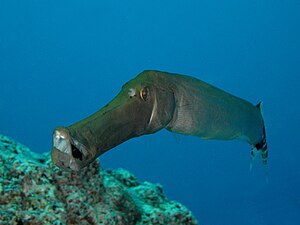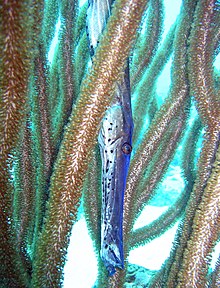Trumpet fish
| Trumpet fish | ||||||||||||
|---|---|---|---|---|---|---|---|---|---|---|---|---|

East Atlantic Trumpetfish ( Aulostomus strigosus ) |
||||||||||||
| Systematics | ||||||||||||
|
||||||||||||
| Scientific name of the family | ||||||||||||
| Aulostomidae | ||||||||||||
| Rafinesque , 1815 | ||||||||||||
| Scientific name of the genus | ||||||||||||
| Aulostomus | ||||||||||||
| Lacepède , 1803 |


The genus of the trumpet fish ( Aulostomus ) belongs to the order of the pipefish , includes only three known species and is monotypical in the family Aulostomidae. Their slim, elongated body makes them almost unmistakable - only a confusion with the even slimmer, but mostly longer and paler flute fish is obvious. Trumpet fish come in different colors, which are usually very well adapted to the environment. The exception is Aulostomus chinensis , which is usually bright yellow. In tropical seas, trumpet fish mostly live in coral reefs , juveniles also in seagrass meadows .
features
Trumpet fish grow to be 75 centimeters to one meter long. Your head can be a third of the standard length. The mouth is tubular and occupied by small teeth. At the tip of the lower jaw there is a fleshy barb . The scaly body is elongated and laterally flattened. The number of vertebrae is 59 to 64, including 24 to 26 trunk vertebrae and 35 to 38 tail vertebrae. The trunk vertebrae have two similar lateral outgrowths. The body muscles are supported by a network of interwoven bony structures (proven for A. chinensis ). The lateral line organ is well developed.
Fin formula : dorsal VIII – XII / 23–28, anal 25–28, ventral 6.
The short hard rays of the dorsal fin sit isolated from one another and without a fin membrane, roughly in the middle of the body. The soft-rayed dorsal fin forms with the opposite anal fin and the rounded caudal fin sitting on a slim caudal stalk, the main driving organ of the shock predators. The pelvic fins sit far back, roughly in the middle of the body, the anus just before the anal fin.
Way of life
Trumpet fish are diurnal predatory fish. In reefs you can often see them not only horizontally, but also in a wide variety of inclines and even vertically, but motionless, standing in the water, so - z. B. in seaweed, between sea fans or soft corals - to hide. The trumpet fish join in the movements of their hiding places caused by currents or waves. They feed on small fish and can jump out of their resting position in a flash when hunting. A special hunting technique is shown in the picture below on the right: the trumpet fish swims close to one or two other fish in order not to be noticed by possible victims. The yellow Aulostomus chinensis often chooses the yellow rabbit fish for this . From this cover he then strikes at lightning speed.
Reproduction
Little is known about the reproductive biology of the trumpet fish. Courtship play was observed in open water, in which several males and one female are involved. After a while, only one male remains to continue courtship. Spawning takes place after sunset, shortly before complete darkness. Trumpet fish eggs and larvae have not yet been described.
species
| German name | Scientific name | distribution | image |
|---|---|---|---|
| Pacific trumpet fish |
Aulostomus chinensis ( Linnaeus , 1766) |
Tropical Indo-Pacific |

|
| West Atlantic Trumpet Fish |
Aulostomus maculatus Valenciennes , 1841 |
Tropical western Atlantic |

|
| East Atlantic Trumpet Fish |
Aulostomus strigosus Wheeler , 1955 |
Tropical Eastern Atlantic |

|
literature
- Joseph S. Nelson , Fishes of the World , John Wiley & Sons, 2006, ISBN 0-471-25031-7
- Kurt Fiedler: Textbook of Special Zoology, Volume II, Part 2: Fish . Gustav Fischer Verlag Jena, 1991, ISBN 3-334-00339-6
- Rudie H. Kuiter : Seahorses, pipefish, shredded fish and their relatives , 2001, Verlag Eugen Ulmer, Stuttgart, ISBN 3-8001-3244-3
- Hans A. Baensch / Robert A. Patzner: Mergus Sea Water Atlas Volume 6 Non-Perciformes (Non-Perciformes) , Mergus-Verlag, Melle, 1998, ISBN 3-88244-116-X
Individual evidence
- ↑ Baensch & Patzner, 1998